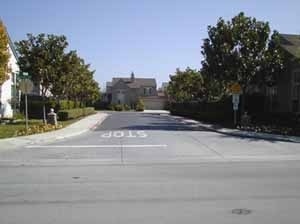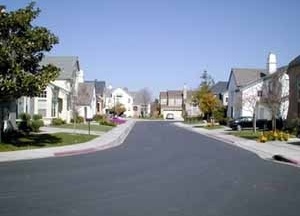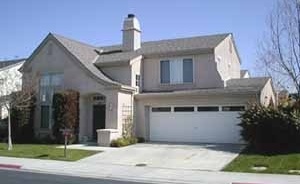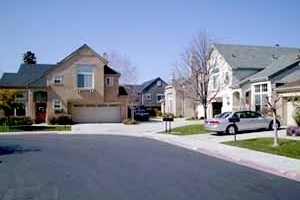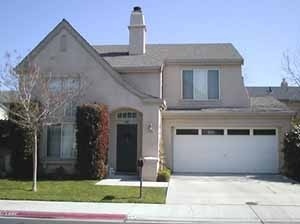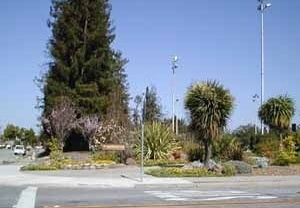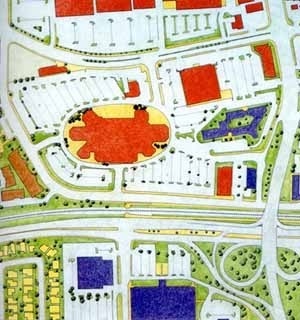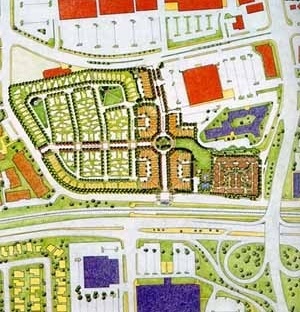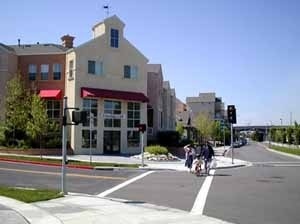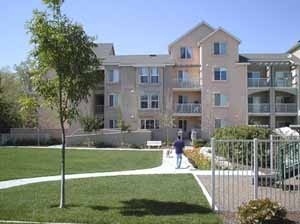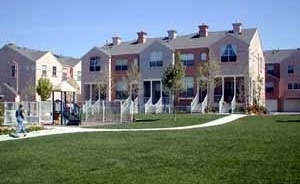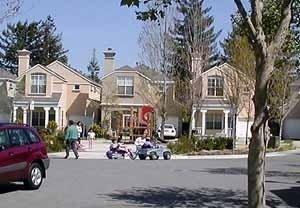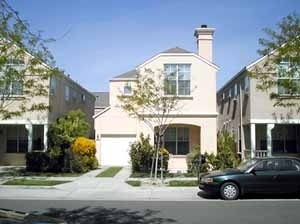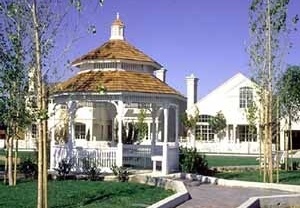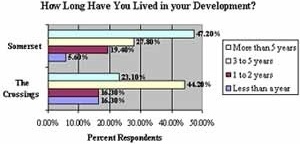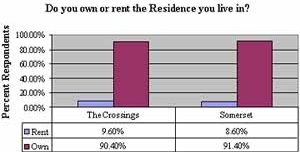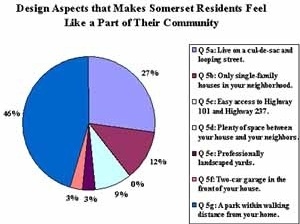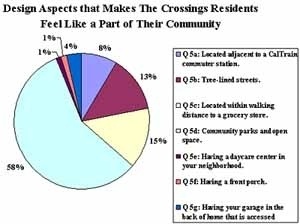This paper discusses a research on automobile dependency and sense of community in residential environments in California. In the broader context, the research aims at contributing to a better understanding of New Urbanism design and its influences in the life patterns, sense of community, and daily behavior of stakeholders, moreover, residents of new developments which have been built according to the New Urbanist agenda.
The research described hereon concentrated in the effectiveness of residential urban design in response to some of the key tenets of new urbanism. Our original questions were: a) how this design truly reflects on the daily lives of the communities’ residents; and b) how residents perceive it? To answer these questions, the research focused on 1) automobile dependency and 2) sense of community, as the two major variables of new urbanism.
We decided that a comparative study of a new urbanism development to a standard suburban development in the San Francisco Bay Area was the appropriate research method. Two case studies were adopted, both in California: The Crossings, a new urbanism development n Mountain View, and the Somerset, a suburban development in Sunnyvale. These two developments are similar to each other in terms of building age, starting home sale price, and residential demographics.
Based on existing literature on New Urbanism, and on the reasoning of this movement, we expected to find that residents of the new urbanism development had a greater sense of community in their neighborhood and have less dependence on their automobiles for routine trips than residents of the traditional suburban development.
For our evaluation we compared design aspects, as well as the residents’ perceived sense of community, and their automotive dependence. Residents of both developments were surveyed for their design preference, sense of community, and automotive dependence as constructed from relevant literature. To measure the accuracy of new urbanism in each development, both were evaluated against the New Urbanism Index of Neighborhood Characteristics (developed by Dr. Patricia Patterson, Oregon Health and Science).
Theoretical framework
Suburban growth has been the greatest transformation of our environment and cultural landscape in the U.S. since World War II. The introduction of zoning regulations, increased mobility due to advances in transportation, and Federal policy changes enabling more Americans to purchase homes, where the three major changes that greatly altered our civic culture and patterns in residential development.
The suburbs became the “American Dream” but, despite all they represented, they began to lose their original appeal, leading to new design concepts geared to regain sense of community and place that had been lost. In reaction to the suburban development of the post-war period, architects began to devise new designs to regain these “lost” elements. The most notable of these designs are: 1) New Town community design, 2) the planned unit development (PUD), and 3) New Urbanism.
Three main concepts directed our research. Automobile dependency is defined by the lack of alternative modes of transportation that would give residents the opportunity to reduce the amount of car trips they would need to make from their neighborhoods. This definition is based on the Victoria Policy Institute’s definition of automobile dependence as “the cumulative effect of transportation and land use patterns that result in high levels of automobile use and limited transportation alternatives (VTPI, 2003). Sense of community is defined as a way of life; a setting where people work together and achieve common goals; a place where social bonds are formed; and where a sense of belonging can be achieved (Schwartz, 1991). And finally, new urbanism may be defined as “an expansion of relatively narrow neotraditional design principles to larger scale planning issues: regional planning, transportation engineering, retail marketing, and agriculture land protection” (Furuseth, 1997, p. 201).
We also looked into the main types of research that has been conducted on new urbanism, and were able to group them into four categories: 1) media accounts, 2) theoretical papers, 3) descriptive studies, and 4) indicators. Media accounts, including newspaper and magazine articles and published books, generally provide a positive report of new urbanism as well as a mainstream outlet for the discussion of alternative design styles. Theoretically-based articles and papers have encouraged an open debate on the positive measurements of design principles on new urbanism residents, as well as calling new urbanist definitions into question. Several comparative studies have been conducted on conventional suburban communities and new urbanism developments to research the successes and differences. Indicators researched include New Urbanism Index of Neighborhood Characteristics (Dr. P. Patterson, Oregon Health & Science). The index is a 29-item 3-point scale created to measure different types of neighborhoods to aid in gauging the pedestrian friendliness of built environments, and it is administered by measuring aspects of a resident’s face block and the surrounding ¼ mile neighborhood area. The tool was pre-tested in 18 census tracts selected from census data. Reliability in was r = .93 in 29-item index (Patterson & Chapman, 2002).
New urbanism and auto dependency
New urbanism’s design approach claims to reduce automobile dependence through a combination of the following: 1) a reduction in the surface street distance between locations, 2) a mix in land uses, and 3) encouraging alternative transportation modes such as walking, bicycling, and transit. The principle goal is to develop a mix of services within walking distance of homes which should encourage residents to walk more and should allow them to accomplish more in one trip, resulting in an overall reduction in the number of trips. New urbanism designs incorporate narrow streets, human scale streetscapes that reduce auto access to create a more pedestrian friendly environment, and the use of a grid street system, which is thought to be a more accessible system, provide more trip route options, and therefore decrease traffic congestion.
New urbanism and sense of community
According to existing literature on New Urbanism, social interaction may be generated and a sense of community may be fostered by design configuration and design elements, particularly through: a small distances between houses, a variation of housing types, a mix of services and uses, front porches, narrow streets, public spaces, and by pedestrian friendly amenities. New urbanists also believe that residents of mixed-use neighborhoods have more social interaction and a greater sense of community than residents living in neighborhoods that are zoned single use. To maintain a community identity that promotes a sense of place, they make use local architectural styles and materials, and contextualise new design patterns to those of the lay-out of neighboring communities.
Research methods
The research tries to understand the patterns of relationships between two or more variables within two communities. These variables include physical attributes of the developments and the residents’ perception of sense of community and automotive dependence. The evaluation of the two developments, The Crossings and The Somerset, compares the design aspects as well as the residents’ perceived sense of community and automotive dependence.
Residents of both developments were surveyed regarding their design preference, sense of community, and automotive dependence as constructed from relevant literature. The survey consisted of four sections: section one examined the residents’ sense of community; section two examined the physical characteristics of each development; section three investigated the residents’ automobile dependence; section four addressed demographics, and the final question was open ended, asking what each respondent would change within his or her respective development. Surveys were distributed door-to-door over a 3-day period in November, 2002. Each survey included a cover letter, and follow up interviews were conducted with those participants who wished to provide further feedback.
To measure the accuracy of new urbanism in each development, the two developments were evaluated by using the New Urbanism Index of Neighborhood Characteristics (P. Patterson, Oregon Health and Science).
Results
Demographics – Based on the demographics questions, the two developments are very similar. Both have the same number of renters and homeowners, average resident age, average number of children in the household, dual income households, approximate household income, and education level. These demographic results support that these two developments are comparable communities.
Sense of Community – The results of the demographics support the idea that each development has the same positive influences on their sense of community. Both developments have a similar amount of sense of community among their residents, and residents of both developments know a similar number of individual neighbors on a first name basis. However, there is a significant difference in that residents of Somerset have lived in their development longer, a result which indicates that The Crossings created a similar sense of community in a shorter amount of time.
Design Features – The results of the index found that The Crossings had an overall higher score of 26% than Somerset. The Crossings scored 14% higher on the face-block characteristics and 41% higher on the neighborhood characteristics than Somerset. The two developments had some similar design characteristics such as small front yards and traditional residential designs. However, the developments differed in neighborhood layout as The Crossings incorporates a mix of land uses, has more open space and parks than Somerset, which is purely residential.
Design Aspects Associated with Sense of Community – The Crossings residents correlate community parks and open space with promoting sense of community. Despite what residents reported, on-site community day care and a front porch on their home are both features that promote a sense of community by facilitating social interaction among families with small children and between neighbors. Somerset residents report that living on a cul-de-sac and looping street are the most important design features giving them a sense of community with neighbors.
Automotive Dependence – There is no significant difference between the number of licensed drivers in the household and the number of working cars or light trucks between The Crossings and Somerset.
The Crossings residents used more public transportation to get to work than those in Somerset, and Crossings residents also made more weekly trips than did Somerset residents. The Crossings residents drove less by themselves and walked more when they went food shopping. They also made more non-food retail trips in a week than Somerset residents.
The Crossings residents drove by themselves more when they made their non-food retail trips compared to Somerset residents, but Crossings residents also walked more to their non-food retail trips than did Somerset residents. The Crossings residents walked more than the Somerset residents when they visited friends and family. Results show that residents of The Crossings use more alternative transportation more frequently when they do their food shopping trips and visit friends and family. They also may make more shopping trips because the shopping is within walking distance to their residence.
Conclusions
1. What are the design features that distinguish The Crossings from the Somerset as a new urbanist development?
The Crossings is a pedestrian-oriented, mixed-use community, along with the inclusion of a wide range of housing types, from small-lot family homes, to townhouses, and condominium, a recreation component of three pocket parks with a community center and swimming pool, and neighborhood-serving retail stores. Somerset was designed as a conventional suburban development with typical architectural characteristics including wide curvilinear streets and cul-de-sacs, houses on same-size lots with the same architectural style. Somerset is strictly a residential development and does not include any other uses or services, landmark structures, or common areas.
2. Does the new urbanism development (The Crossings) provide for a greater sense of community within its neighborhood than the Planned Unit Development (Somerset)?
The data do not indicate that residents of The Crossings had a greater sense of community in their neighborhood than those residents of the Somerset development. However, it can be inferred from the results that The Crossings created a similar sense of community in a comparatively short amount of time. The high density design of The Crossings may account for increased frequency in interactions among its residents and may contribute to residents’ sense of community occurring over a shorter time period than in a more conventional suburban development which doesn’t create as many opportunities.
3. Which design aspects do the residents associate with a sense of community in their neighborhood?
The Crossings residents associate community parks and open space, residing within walking distance to a Safeway grocery store, tree lined streets, having a daycare center in the neighborhood, and having a front porch with a positive sense of community in their neighborhood. Somerset residents regard the design aspects of a park within walking distance from home, living on a cul-de-sac and looping street, having only single-family houses in their neighborhood, plenty of space between neighboring homes, and easy access to Highways 101 and 237 as the most important attributes of their sense of community.
4. Do residents of The Crossings have lower automobile dependence than residents of the PUD in their daily activities?
Residents of the Crossings seem to use their automobiles less than residents of Somerset in certain instances, such as food shopping and visiting friends and family. The data does not directly conclude that there is an overall lower auto dependency for residents of The Crossings versus residents of Somerset.
Despite the constraints of this study, limited by the number of comparable developments and the self-selection bias, it seems that the case study method is the most appropriate strategy when the study is to be based on a social phenomenon such as sense of community and automobile dependence. Although comparative studies may not be exhaustive enough to adequately evaluate new urbanism against suburban neighborhoods, this research provides useful foundation for looking into future topics on new urbanism principles.
bibliography
FURUSETH, O. (1997). Neotraditional planning: a new strategy for building neighborhoods. Land Use Policy, vol. 14 # 3.
PATTERSON, Patricia (1997). New Urbanism and the elderly in urban and suburban neighborhoods. Tese de Doutorado em Estudos Urbanos. Portland University, OR.
PATTERSON, Patricia & Nancy Chapman (2002). New Urbanism index of neighborhood characteristics. Trabalho apresentado no congresso da Environmental Design Research Association (EDRA); Philadelphia, 2002.
SCHWARTZ, Peter (1991). The art of the long view. New York: Doubleday.
VTPI – Victoria Transport Policy Institute (2003). The cost of automobile dependency and the benefits of balanced transportation. Informação disponível on-line (15/01/03): www.vtpi.org.
about the authors
Trevor Keith, Graduate Student, City and Regional Planning Department, Cal Poly San Luis Obispo.
Vicente del Rio, Associate Professor, City and Regional Planning Department, Cal Poly San Luis Obispo.



